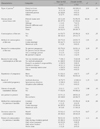Abstract
Purpose
This study aimed to identify differences in contraception behavior and related factors between unmarried female and male.
Methods
A cross-sectional survey design with a convenient sampling was used. From Seoul, 107 women and 96 men were recruited. A structured questionnaire was self-administered from July 14, 2008 to September 2, 2008.
Results
The average ages of women and men were 26.9 and 27.8 years old, respectively. Fifty-six percent of women and 85.4% of men have experienced sexual intercourse. There were no differences between female and male in attitude toward contraception, subjective norm, and contraception behavior, while female had higher score of self-efficacy for contraception (p=.02) and intention of contraception (p=.02). There was positive correlation with subjective norm (r=.22, p<.05), self-efficacy (r=.53, p<.01) in male and attitude (r=.32, p<.05), self-efficacy (r=49, p<.01) in female. According to the result of multiple regression, the significant factor of contraception behavior was self-efficacy for both female (β=.49, p=.00) and male (β=.53, p=.00).
Figures and Tables
Table 2
Gender Differences in Contraception in Regard to Attitude, Subjective Norm, Self-efficacy, Intention, Contraception Behavior (N=203)

References
1. Agha S., Rossem R.V. Impact of a school-based peer sexual health intervention on normative beliefs, risk perceptions, and sexual behavior of Zambian adolescents. Journal of Adolescent Health. 2004. 34(5):441–452.
2. Ajzen I. The theory of planned behavior. Organizational Behavior and Human Decision Processes. 1991. 50:179–211.
3. Baele J., Dusseldrop E., Maes S. Condom use self-efficacy: Effect on intended and actual condom use in adolescents. Journal of Adolescent Health. 2001. 28(5):421–431.
4. Boer H., Mashamba M.T. Gender power imbalance and differential psychosocial correlates of intended condom use among male and female adolescents from Venda, South Africa. British Journal of Health Psychology. 2007. 12(1):51–63.
5. Catania J.A., Gibson D.R., Chitwood D.D., Coates T.J. Methodological problems in AIDS behavioral research: Influences on measurement error and participation bias in studies of sexual behavior. Psychological Bulletin. 1990. 108:339–362.
6. Cha E.S., Kim K.H., Doswell W.M. Influence of the parent-adolescent relationship on condom use among South Korean male college students. Nursing & Health Sciences. 2007. 9(4):277–283.
7. Cha E.S., Kim K.H., Patrick T.E. Predictors of intention to practice safer sex among Korean college students. Archives of Sexual Behavior. 2007. 37(4):641–651.
8. Cho J.Y., Han S.W., Song M.S. Personality-based contraception behavior of female college students. Korean Journal of Women Health Nursing. 2006. 12(4):338–347.
9. Choi M.S., Ha N.S. A study on knowledge, attitude, and experience in sex and sexual autonomy of college students. Korean Journal of Women Health Nursing. 2004. 10(4):318–330.
10. Cohen J. Statistical power analysis for the behavioral science. 1988. 2nd ed.Hillsdale, NJ: Lawrence Earlbaum Associates.
11. Galavotti C., Cabral R., Lansky A., Grimley D.M., Riley G.E., Prochaska J.O. Validation of measures of condom and other contraceptive use among women at high risk for HIV intention and unintended pregnancy. Health Psychology. 1995. 14(6):570–578.
12. Hur M.H., Ahn H.Y., Kwak E.A., Kim K.M., Park J.Y., Lee J.I.R. A study on sexual behavior, and correlation between knowledge of contraception and attitude of contraception among university students. Journal of Korean Academy of Nursing. 2007. 37(3):267–275.
13. Jeon G.S., Lee H.Y., Rhee S.J. Sexual knowledge, attitudes and behaviors of Korea college students and effects of sexual education on sexual knowledge and attitude. Journal of Korean Society for Health Education and Promotion. 2004. 21(1):45–68.
14. Jeoug H.J. Research on the sexual consciousness and sexual behaviours of single males and females. 2001. Seoul: KyungHee University;Unpublished doctoral dissertation.
15. Jung Y.M. Predictors of intension to use condom of unmarried men in their 20s. 2004. Seoul: Seoul National University;Unpublished master dissertation.
16. Kang H.S. Explanatory model of condom use among Korean college students. 2001. Seoul: Yonsei University;Unpublished doctoral dissertation.
17. Kang H.S., Chang S.B. Development of college students' condom attitude scale. Journal of Korean Academy of Nursing. 2004. 34(5):751–759.
18. Kim H.J. A survey and general counterplan for abortion. Supported by Ministry of Health & Welfare. 2005. Retrieved November 20, 2008. Seoul: Korea University;from http://www.profile.or.kr.
19. Kim M.H. The effect of the contraceptive education program based on theory of planned behavior on contraceptive behavior. 1997. Seoul: Hanyang University;Unpublished doctoral dissertation.
20. Kim M.J., Kang H.S. A comparative study of consistent and inconsistent contraceptive users on partner communication, perceived contraceptive control, and sexual autonomy. Journal of Korean Academy of Nursing. 2003. 33(6):784–791.
21. Korean National Statistical Office. Annual report on the economically active population survey. 2005.
22. Lee I.S., Park E.H., Lee J.J. A survey of attitude toward sex of unmarried women in South Korea. Korean Journal of Obstetrics and Gynecology. 2006. 49(1):157–167.
23. Lee S.H., Han S.H., Lee M.S., Jo H.S., Chae Y.M., Yoo S.H. A study on factors related to sex behavior and attitude of unmarried person. Journal of Korean Society for Health Education and Promotion. 2000. 17(2):1–15.
24. Munoz-Silva A., Sanchez-Garcia M., Nunes G., Martins A. Gender differences in condom use prediction with theory of reasoned action and planned behaviour: The role of self-efficacy and control. AIDS Care. 2007. 19(9):1177–1181.
25. Salabarria-Pena Y., Lee J.W., Montgomery S.B., Hopp H.W., Muralles A.A. Determinants of female and male condom use among immigrant women of central American descent. AIDS and Behavior. 2003. 7(2):163–174.
26. Wang R.H., Wang H.H., Cheng C.P., Hsu H.Y., Lin S.Y. Testing a model of contraception use behavior among sexually active female adolescents in Taiwan. Research in Nursing & Health. 2007. 30:628–640.
27. Wulfert E., Wan C.K. Condom use: A self-efficacy model. Health Psychology. 1993. 12(5):346–353.
28. Yarnall K.S., McBride C.M., Lyna P., Fish L.J., Civic D., Grothaus L. Factors associated with condom use among at-risk women students and non students seen in managed care. Preventive Medicine. 2003. 37(2):163–170.




 PDF
PDF ePub
ePub Citation
Citation Print
Print






 XML Download
XML Download